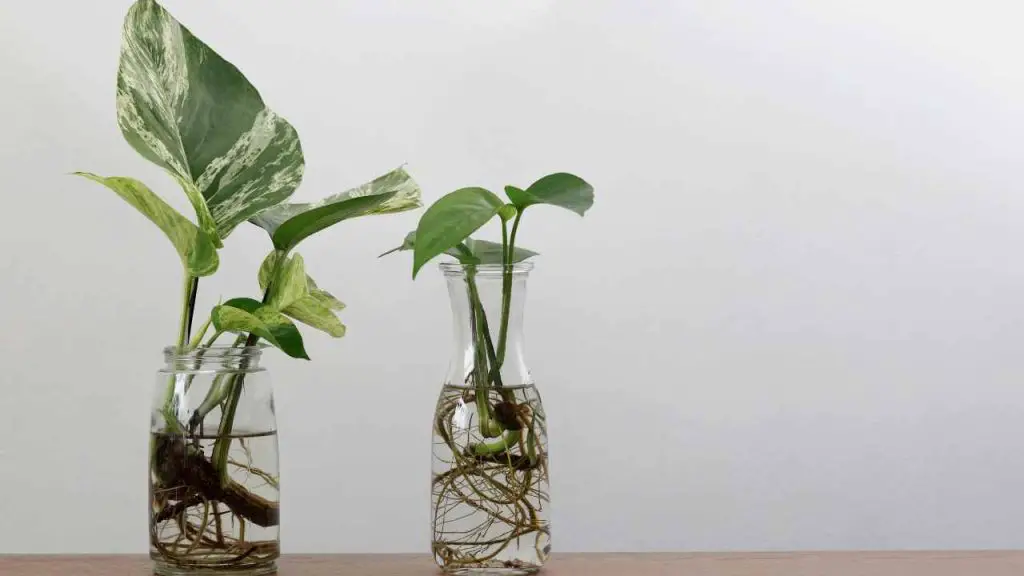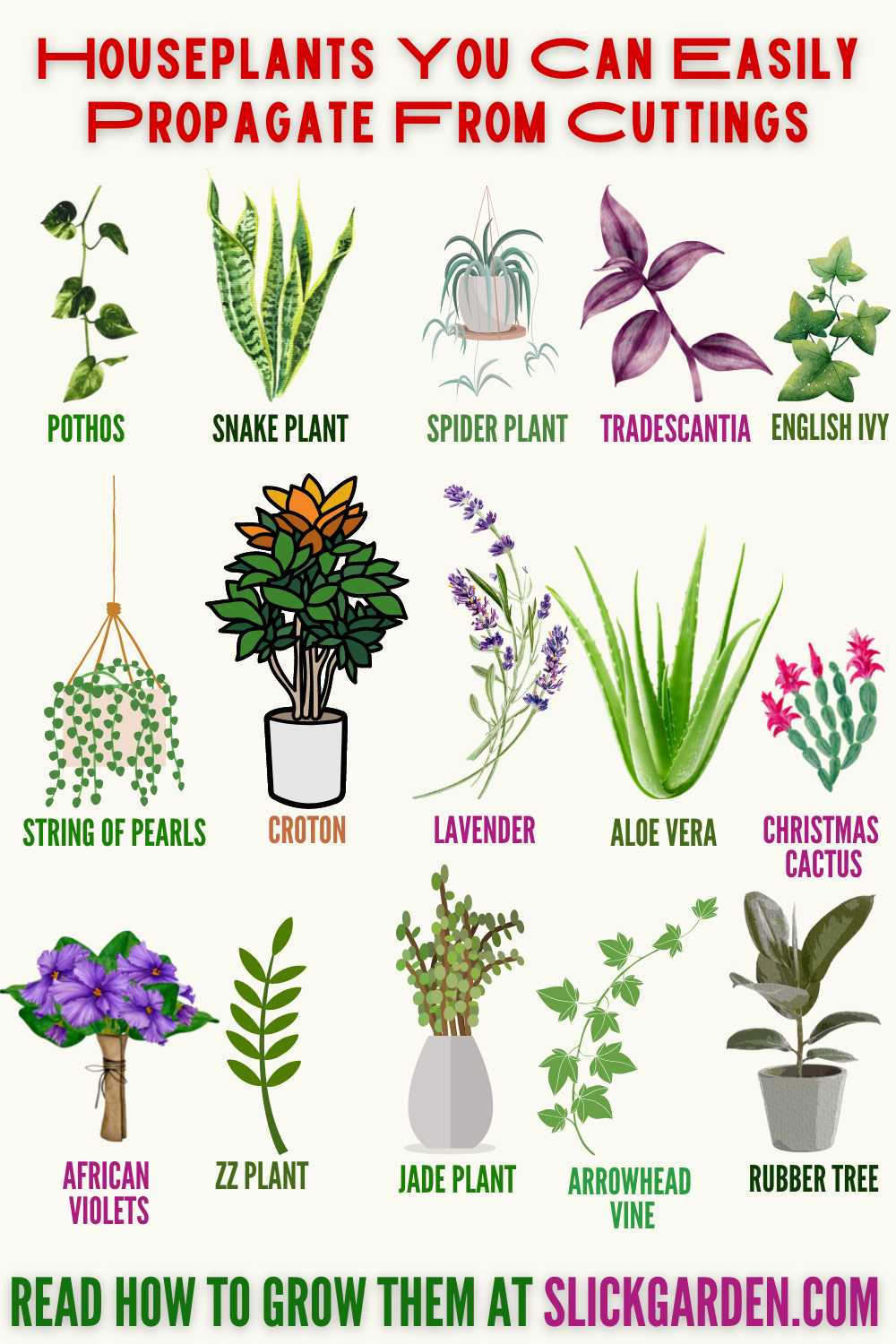There is no need to buy new plants because many plants can propagate from cuttings. When you use cuttings for growing plants then it will save you money and you can add more plants to your space.
Propagation from the cutting is a popular method for indoor and as well as outdoor plants. The new houseplant that propagates from cuttings will be genetically identical to its parent plant.
You need stem cuttings off of your favorite plant and place them in the potting mix. When roots start emerging from the cuttings then this is the right time of transplanting these cuttings into your desired part.

You can also put the cuttings in the water and wait for the rooting. After that, you can transplant the cuttings into your desired pot but before doing this you must check whether your plant can grow in water.
Because not all houseplants can grow in water. In case you want to propagate a flowering plant from stem settings then make sure the cuttings must not have any flower bird or flower.
The reason is that when you plant the cuttings the full energy will be utilized for developing the roots.
When Should You Propagate Your Houseplants?
The best time to propagate your house plant is during their growing season; mostly you can propagate your house plans in spring to summer. During the months of autumn and winter, your plants will be in dormant condition so they will grow very slowly.
Before selecting your houseplants for propagation from stem cuttings You must do some research on whether your favorite houseplant can easily grow from stem cutting or not.
Make sure the method for propagation must be best. Sometimes they grow well when they propagate through a division method and some like to propagate from leaf cuttings.
17 Houseplants You Can Easily Propagate From Cuttings

Propagation of new plants from stem cuttings is an inexpensive way. There are a number of plants that can easily propagate and turn into new plants without doing anything.
1- POTHOS
Pothos are included in those plants that can easily propagate from cuttings. Pothos can thrive well in both soil and water. For creating new baby plants you need cuttings.
You should cut the vine just at a point below where a new leaf is coming out. Nodes must be present in each cutting because the roots will emerge from these nodes.
Put these cuttings in a glass jar that is filled with water. The new roots start developing after 2-4 weeks. When you see the roots are about 1 inch long then this is the right time to plant these cuttings in the soil.
2- SNAKE PLANT
The easiest and fastest way of propagation of snake plants is from division. The other way of propagating snake plants is from leaf cuttings. Take a leaf of a snake plant and put it in water.
Keep the cuttings in a warm climate so they can easily develop the roots. After some time roots start emerging from this leaf cutting. It is an ideal time to plant these prepared leaf cuttings.
Fill your pot with high-quality and well-drained soil so your cuttings can easily adjust to the new environment.
3- SPIDER PLANT
This low-maintenance plant can easily propagate by root division, from seeds, or by rooting plant babies. Rooting plants is the best and easiest way of propagating spider plants.
For growing spider plants, You must fill your pot with a high-quality potting mix. The potting mix contains perlite and peat moss that are best for your plants.
Bright and direct light is perfect for growing spider plants. This plant needs water once a week during the growing season. You must reduce the frequency of water in autumn and winter.
4- STRING OF PEARLS
This is a perennial vine that belongs to the succulent family. This is a self-propagating plant because it develops new baby plants around the mother plant.
Fill a pot with a high-quality potting mix and place it below your hanging basket of the string of pearls. After that, layer a string of pearls on top of the soil. Regularly water the soil.
Soon you will see the new rules will start emerging from the hanging parts of string on pearls. When new roots are developed then you can detach the mother plant from the new plant.
5- TRADESCANTIA
If you have a large bushy tradescantia plant then you can propagate it. You need stem cuttings with 2 to 3 leaf nodes. Now please cut your cuttings in water before planting them.
When you see the roots start emerging from the cuttings you can plant these cuttings. You can also plant the cutting directly in the soil without placing them in water.
6- ENGLISH IVY
For growing English ivy from stem cuttings, you need 4 to 5 inches long shoots. Remove leaves on the bottom portion of the cuttings. If you want to speed up the rooting process then dip the end of the cuttings in a rooting hormone.
Now plant the cuttings in perlite. Regular watering with full sun exposure helps in the growth of roots. After 6 to 8 weeks you will see the roots. When cuttings have a good root system then you can transplant them to their permanent location.
7- CROTON (Codiaeum)
For propagating croton from cuttings, you need three to four inches long stem cuttings. Take a sharp pruner and cut the long cuttings that have at least three sets of leaves.
Prepare a pot for planting the cuttings. Fill your pot with a lightweight potting mix. After planting the cuttings, water them well so they can easily adjust to the new environment.
Keep Reading
- Houseplants Decor For Your Kitchen
- How To Use Grow Lights For Houseplants To Help Them Thrive
- How To Make Houseplants Grow Faster?
8- LAVENDER
If you are living in a warm climate then you can propagate lavender at any time of the year but in case of a cold climate, the best time for planting the cuttings is in spring.
Lavender is included in such plants that can easily propagate from stem cuttings. You can select any variety of your desired lavender and take 4 to 6 inches of stem cuttings.
Remove the bottom leaves from the cuttings. Propagating lavender in the water can be tricky because this plant is susceptible to root rot. Soil is the best friend medium for lavender plants.
9- ALOE VERA
Aloe Vera is also included in our list because it can easily propagate from cuttings. This plant belongs to the succulent family and it has many benefits.
It is better to take the cuttings from a healthy large aloe vera plant. Carefully examine the base of aloe vera plants there are small plants that are thriving.
These plants are called pups. You can give these pups new homes. Carefully pull the pups from this soil without disturbing the mother plant. Repotting these smaller plants is very easy and does not affect the health of the mother plants.
10- CHRISTMAS CACTUS
Christmas cacti belong to a succulent family. A few segments of the mother plant are enough to create new plants. Select a y-shaped piece of this houseplant with at least three leaf segments.
Plant your cuttings in a high-quality potting mix and keep the soil moist. All the segments should be planted in such a way that the soil covers ½ inch above the node. Bright and indirect light is perfect for Christmas cacti.
11- AFRICAN VIOLETS
If you want to propagate adorable flowering houseplants then African violets are one of them. You can easily propagate them from leaf cuttings. A single cutting will turn into a new plant.
Cut the leaf-cutting at a 45-degree angle. Now plant this cutting in moist potting soil. A moist and humid environment is perfect for the growth of new roots. Tiny leaves start after a few weeks.
Carefully examine this young plant when you see there are 42 sex new leaves on the new plant then this is the right time of transplanting it to its permanent location.
12- ZZ PLANT
ZZ plants are included in such plants that need little maintenance. If you don’t have time to take care of your plants regularly then you must grow this plant because it can tolerate your negligence.
This plant is also a good choice for beginners who don’t know about gardening. Another interesting thing about this plant is that it can easily propagate with tuber-like rhizomes that are present at the base of each stem.
You should carefully inspect the place where roots grow. This is the place where you can take the stem cuttings. Place the cuttings in water. Make sure these cuttings receive full sun exposure so a sunny location is perfect.
After 3 to 4 weeks you will see cuttings start producing new roots. When the roots are an inch long then this is the time to plant these cuttings in a well-drained and high-quality potting mix.
13- JADE PLANT
The thick woody stems produce oval-shaped leaves that are very fleshy and glossy. You can easily propagate Jade plants from leaf cuttings. Make sure you take the cuttings from a mature plant.
Now fill a shallow tree with high-quality soil mi. Lay all the leaves over this soil mix. This propagating process is similar to succulents. You can also use stem cuttings for growing Jade plants.
You need 4 to 6 inches long stem cuttings. Now plant these cuttings in your desired pot. After some time these cuttings will turn into a new plant.
When the size of your plant is small then you can use a 4 to 6 inches pot. As the plant grows you can transplant it into a bigger one.
14- ARROWHEAD VINE
You can easily propagate Arrowhead plants from cuttings. All you need is 6 to 12 long stem cuttings and soil. You can place these cuttings in moist soil or directly in the water. After 1 to 2 weeks you will see new roots start emerging. After 4 weeks you will see new growth of leaves.
15- STRING OF BANANAS
This is a unique circular vine that has banana-shaped leaves. You can easily propagate a string of bananas by using short cuttings or leaves.
The string of bananas likes to grow in well-drained and porous soil. It is better to use cactus potting soil to mix your soil richer. You can add compost.
16- RUBBER TREE
The addition of rubber plants gives a tropical look to your living area. In ideal outdoor conditions, tropical plants can be grown up to 100 ft. When you grow a rubber plant as a houseplant then you should regularly prune the plant to keep the size of the plant according to your desire.
The ideal time for propagating rubber trees is in spring. If you propagate plants in fall or winter then they will not grow or recover quickly.
Keep Reading
17- WEEPING FIG
Take the stem cuttings of a healthy weeping fig plant and place them in the soil or water for propagation. Avoid wearing the method because the success rate of water and soil propagation is very high.
Carefully examine the cuttings when you see the new growth then you can plant in your desired pot or container.
